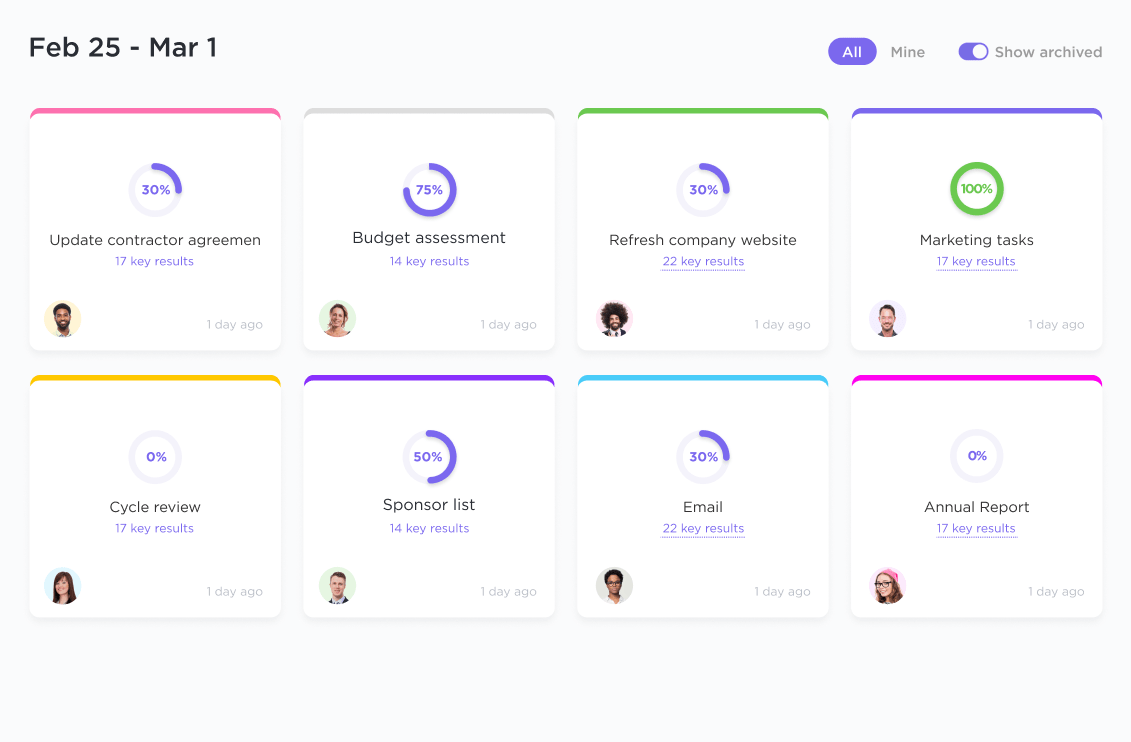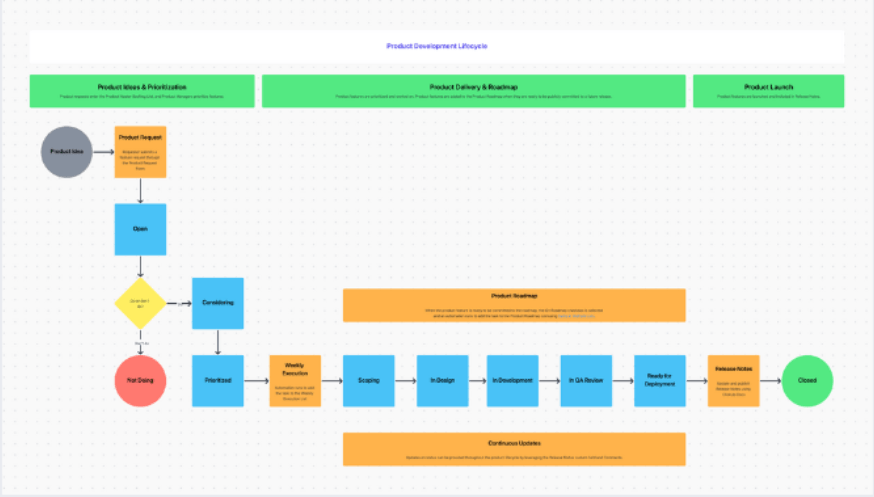Product Management Frameworks: Techniques for Successful Strategy

Sorry, there were no results found for “”
Sorry, there were no results found for “”
Sorry, there were no results found for “”
In terms of technology, we are living in exponential times. Meaning, every time we blink, there is a new invention making our lives easier.
And we have product managers to thank for it. 👊
As a product manager, you serve as the liaison between engineers and consumers. It’s your job to gather intel on what customers want most—whether it be a new product or a new feature of an existing product—then communicate those wish lists to the product development teams.
Sound complicated? It can be—but product management frameworks help simplify the process. Below, we explain what product management frameworks are, how they’re implemented, and the best framework for your business.
Product management frameworks are standardized processes of improving a product. Essentially, a product management framework takes a product (or a feature of a product) from vision to post-launch, helping to keep all teams on the same page. 🙌
While each framework is unique, it typically follows five stages, which are all critical to the success of the product. These stages include discovery, definition, development, launch, and growth—taking a product from a far-off vision to a tangible product in the hands of consumers.
The right product management framework can be the difference between a successful launch or a complete flop. And yet, according to a study by McKinsey, 75% of product managers state that product management best practices haven’t been adopted by their respective companies.
To set your team (and future product line) up for success, consider utilizing one of these tried-and-true frameworks. 📚
The Double Diamond model is often used in user experience (UX) design. The model features two diamonds: one representing the problem, and the other depicting the solution. In other words, product managers use the first diamond to map out core problems of a product, then use the second as a design brief—helping to formulate and test potential solutions.
The CIRCLES Method is a sequential framework allowing product managers to ask essential questions about new products and/or features. The method emphasizes seven critical steps (one for each letter in “CIRCLES”):
The CIRCLES method is meant to serve as a checklist of sorts, allowing product managers to identify goals, constraints, and the context of new product launches.
Designed by Dave McClure, a Silicon Valley investor, the AARRR framework outlines five metrics every product manager should be tracking. The five metrics include:
The model contains two key benefits. One, it helps companies hone in on those metrics that directly impact the health and longevity of their business, and two, it ensures companies use the right data to measure the success of their product management efforts.
Developed by Google, the HEART Framework is an acronym for five user-centric themes:
Google developed the method to help product managers improve the user experience of each product feature.
To quantify each measure, product managers use the Goals-Signals-Metrics approach (also developed by Google). Team members define the goals of each feature, the signals that point toward progress, and metrics to calculate whether they’re hitting their objectives.
The Kano Model uses customer emotions to measure the success of each product. Built on the belief that customer satisfaction starts with an emotional response, the Kano Model measures five response types:
Using a scale of “delighted” to “frustrated,” product managers measure the type of response each product feature triggers in a user.
The RICE Scoring Model helps product managers prioritize which features to launch first. The model evaluates product ideas based on:
A final score is given to each submission. The idea with the highest score shows the highest potential and is then placed on the product roadmap first.
Whereas other frameworks in this list measure products on a variety of features, the North Star Framework measures a product’s potential based on a single metric. Dubbed the “north star,” this crucial metric calculates the value the product delivers to customers. In essence, this one factor is meant to measure customer happiness and the success it could bring to your startup.
The MoSCoW Method helps product management teams prioritize tasks. The acronym stands for:
This framework helps to determine the nonnegotiables of each product. If key stakeholders disagree on which features carry the most weight on the product roadmap, they’ll use the MoSCoW Method to calculate how much internal resources should be dedicated toward each feature launch.
Just as each of the above frameworks is unique, there is a degree of overlap between them. Similarities between the above frameworks include:
That said, these frameworks differ in when and how they’re used throughout the product life cycle. For example:
The Agile Methodology framework is a project management framework that breaks down projects into distinct phases. These phases—known as sprints—give teams the time and space to reflect on what worked (and what didn’t), thereby making tweaks before they move into the next phase.
So, what do agile methodologies have to do with product management? Launching a new product and/or feature is—by nature—a project. And using the right project management tools can help you launch that product on time, on budget, and with the right features to meet customer needs.

There are different types of agile methodologies, including:
Each product management framework helps launch successful products, and one is not necessarily better or worse than the others. However, many teams find that one model is a better fit for their unique company. To help your product team successfully implement a new framework, follow these steps.
Are you looking to launch a brand new product, address a specific customer problem, or acquire a new target market? Before choosing a framework, gather all decision makers and determine your objectives. This will help decipher which frameworks are right for your organization.

Fortunately, with ClickUp Goals, you can achieve your objectives faster. ClickUp Goals allow you to set clear timelines, define measurable targets, and track your progress toward implementing your new framework.
Here’s the good news: The above frameworks have been tested by companies for decades, so you don’t need to start from scratch. With ClickUp’s Project Framework Template, you can create a structured set of procedures for implementing your product framework. From there, you can leverage dozens of ClickUp product management templates to get your team from ideation to launch.

The entire goal of product management is to increase your value proposition to customers. Therefore, after you implement a new framework, continue to collect customer feedback. Did the new framework help improve the customer journey, or do tweaks need to be made?

Fortunately, with the ClickUp Product Feedback Survey Template, you can easily collect product feedback from customers.
Just because a particular model works now, doesn’t mean it will always be the best fit.
The best framework will always depend on your goals as a company (revert back to step one). As customer pain points fluctuate, your team gets new product ideas, or the functionality of your product expands, you might need to find a new framework. Don’t be afraid to experiment with different models at different stages of your company.
There are a number of factors to consider when selecting a framework. Before you decide, take stock of the following:
ClickUp is the all-in-one productivity platform that streamlines all jobs to be done in the product life cycle. With ClickUp Product features, product development teams can bring their vision to market with the following tools. 🤩

With ClickUp AI tools, product managers can easily generate documents, collect customer feedback, and ultimately launch products faster.

Product roadmaps are a tool of working backward from launch to planning—and every micro decision in between. With the ClickUp Product Roadmap Template, teams can move in sync by seeing which tasks come next.

With ClickUp Whiteboards, product management teams can create a visual of their best ideas. ClickUp Whiteboards allow you to brainstorm, strategize, and create a first draft of your product roadmap with the entire team.

Streamlining the product management process ensures you get your product to market on time. With automated workflows from ClickUp, you can automatically set priorities, leave comments, assign tasks, and get approvals from upper management.

With ClickUp Docs, your entire team can collaborate on roadmaps, requirements, and new feature ideas. With rich editing features and the ability to tag team members and assign comments, you don’t get caught up in “versionitis”—and instead move toward a successful product launch.
Product management frameworks help determine which products and/or features will be most profitable for the company. While each model differs, all help measure customer happiness, simplify the product management process, and take new products to market.
To implement a new product management framework, choose ClickUp. ClickUp helps product management teams operate more efficiently through must-have tools like AI, collaborative Docs and Whiteboards, and automated workflows. Plus, ClickUp comes complete with thousands of templates, hundreds of integrations, and multiple views to help launch new products. 👏👏
Ready to see how ClickUp can lead to a successful product launch? Try ClickUp for free today.
© 2025 ClickUp